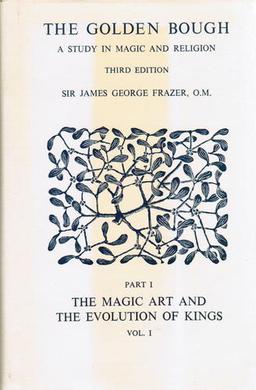
The Golden Bough: A Study in Comparative Religion is a wide-ranging, comparative study of mythology and religion, written by the Scottish anthropologist Sir James George Frazer. The Golden Bough was first published in two volumes in 1890; in three volumes in 1900; and in twelve volumes in the third edition, published 1906–1915. It has also been published in several different one-volume abridgments. The work was for a wide literate audience raised on tales as told in such publications as Thomas Bulfinch's The Age of Fable, or Stories of Gods and Heroes (1855). The influence of The Golden Bough on contemporary European literature and thought was substantial.

Carmel-by-the-Sea, commonly known simply as Carmel, is a city in Monterey County, California, located on the Central Coast of California. As of the 2020 census, the town had a total population of 3,220, down from 3,722 at the 2010 census. Situated on the Monterey Peninsula, Carmel is a popular tourist destination, known for its natural scenery and rich artistic history.
John Patrick was an American playwright and screenwriter.
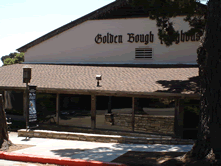
The Pacific Repertory Theatre is a non-profit California corporation, based in Carmel-by-the-Sea, California, that produces theatrical productions and events, including the annual Carmel Shakespeare Festival. It is one of eight major arts institutions in Monterey County, as designated by the Community Foundation of Monterey County, and is supported in part by grants from the David and Lucile Packard Foundation, The Shubert Foundation, the Berkshire Foundation and the Monterey Peninsula Foundation.

Stephen Moorer is a stage actor, director, producer and non-profit administrator based on the Central California Coast. He founded the only year-round professional theatre in Monterey County, GroveMont Theatre in 1982, renaming the non-profit organization Pacific Repertory Theatre in 1994, when the group acquired the Golden Bough Playhouse in Carmel-by-the-Sea, California.
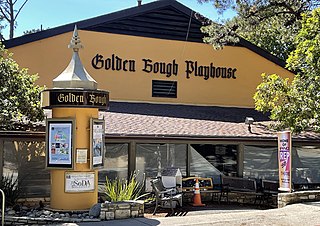
The Golden Bough Playhouse is a historic three-story theatre in Carmel-by-the-Sea, California on Monte Verde St., between 8th and 9th Avenues. The playhouse occupies the site of the former Carmel Arts and Crafts Club, Carmel's first cultural center and theatre, built in 1906–1907 on Casanova Street, and the Arts and Crafts Hall, built in 1923–1924 on an adjacent lot on Monte Verde Street. Since 1994, the facility has been owned and operated by Pacific Repertory Theatre, Monterey County's only year-round professional theatre company. A two-phase renovation of the aging facility began with an interior building project in 2011. A second phase project, including both interior and exterior renovations, is scheduled for 2023-2024. The theatre was recorded with the National Register of Historic Places on July 3, 2002. It is significant as a California historic building because it is located on the original site of the Carmel Arts and Crafts Club and Hall, the oldest indoor performing arts venues in Carmel.

The Theatre of the Golden Bough also known as the Golden Bough Theatre, was located on Ocean Avenue in Carmel-by-the-Sea, California. This "Golden Bough" was one of two theaters in Carmel's history. It was destroyed by fire on May 19, 1935. Kuster moved his film operation to the older facility on Monte Verde Street, renamed it the Filmarte and it became the first "art house" between Los Angeles and San Francisco. It later became the Golden Bough Playhouse that still exists today.
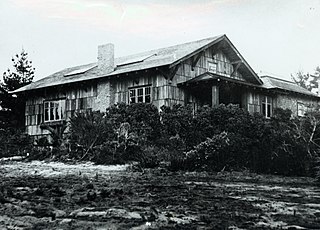
The Carmel Arts and Crafts Club was an art gallery, theatre and clubhouse founded in 1905, by Elsie Allen, a former art instructor for Wellesley College. After using the facilities of various town parks and hotels, in 1907, a clubhouse was built at Monte Verde Street in Carmel-by-the-Sea, California, where the Circle Theatre of the Golden Bough Playhouse is today. The clubhouse served as Carmel's first community cultural center. It held dramatic performances, poetry readings, lectures, and was a summer school for the arts. Between 1919 and 1948 Carmel was the largest art colony on the Pacific coast.

Edward Gerhard Kuster was a musician and attorney from Los Angeles for twenty-one years before coming to Carmel-by-the-Sea, California in 1921. He became involved in theater and establish his own theatre and school. He built the Theatre of the Golden Bough in 1924, and a second theater, the Golden Bough Playhouse in 1952. Kuster directed 85 plays and acted in more than 50 roles in the 35 years he lived in Carmel.

The Carmel Weavers Studio, also known as Cottage of Sweets, is a historic Tudor-style English cottage in Carmel-by-the-Sea, California. It was designed by Edward G. Kuster and constructed by Lee Gottfried in 1922 for Kuster's wife as a weaving shop. Since 1959, it has operated a candy store.

The Seven Arts Shop, is a one-story, wood-frame Tudor Storybook retail shop in Carmel-by-the-Sea, California. It has been designated as a significant commercial building in the city's Downtown Historic District Property Survey, and was recorded with the Department of Parks and Recreation on January 23, 2002.

Sade's, is a historic Tudor-style English cottage in downtown Carmel-by-the-Sea, California. It was designed and constructed by Lee Gottfried in 1925, for novelist and dramatist Harry Leon Wilson and his wife Helen MacGowan Cooke as a flower shop and dress shop. In the 1930s, Sade was a former Ziegfeld Follies dancer, made the lower level into a restaurant and Bohemian bar. It continues to be a restaurant with outdoor seating.

The Abalone League was an amateur baseball and softball club based in Carmel-by-the-Sea, California from 1921 through 1938. It was the first softball league in the Western United States. The League was incorporated on September 8, 1927. The League was a Carmel focal point for many years.

Ira Mallory Remsen , known locally as Rem Remsen, was an American painter, playwright and Bohemian Club member. He was the son of Dr. Ira Remsen chemist and former president of Johns Hopkins University. Remsen was the author of children's plays notably Inchling and Mr. Blunt, he produced at the Forest Theater in Carmel-by-the-Sea, California in the 1920s. His studio on Dolores Street became the permanent home for the Carmel Art Association in 1933.
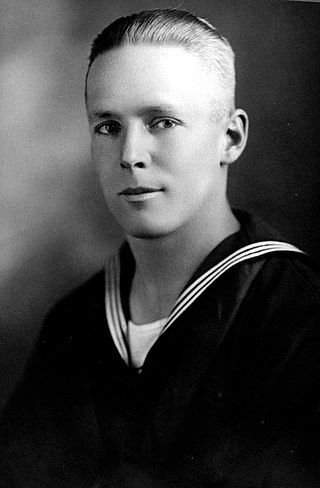
Ernest Seraphin Schweninger was an American actor, realtor, and grocer in Carmel-by-the-Sea, California. He became owner of Carmel's first Bakery and the Schweninger's Grocery Store. Schweninger was a founding member of the Carmel American Legion Post No. 512 and the Abalone League. He appeared in many of the early plays at the Forest Theater and Theatre of the Golden Bough. He became a partner and sales manager for the Carmel Land Company that helped develop Hatton Fields, southeast of Carmel-by-the-Sea.

Lee Gottfried was an American master builder in Carmel-by-the-Sea, California. He had a significant influence on the architecture of the Village of Carmel during his career. Gottfried was one of the main local builders in Carmel and responsible for the first major residential designs done using the local Carmel stone as a building material.

The Blue Bird Tea Room, also known as Blue Bird, was a historic commercial building in downtown Carmel-by-the-Sea, California, United States. Recognized as the oldest tearoom in Carmel, the Blue Bird Tea Room was a popular place for after-theatre dinner parties and luncheon and dinner gatherings attended by both local and visiting celebrities.
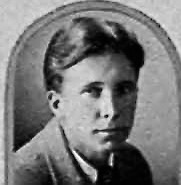
John Cunningham (1904-2004) was an American painter, teacher, and director of the Carmel Art Institute in Carmel-by-the-Sea, California, United States. In 1990, He became president emeritus and transferred the responsibility of the Carmel Art Institute to the Carmel Art Association.
















